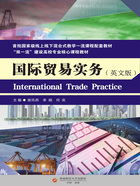
EXERCISES
I. Single Choice
1. According to CISG,a transaction in goods is international if ______________.
A. the subject matter of the transaction is tangible goods
B. the business places of the buyer and the seller are in different countries
C. goods are transported from one country to another
D. the buyer and the seller have formally signed a trade contract
2. Among the following items, ______________ does not belong to the scope of international trade legal norms.
A. domestic laws
B. international trade customs
C. international trade conventions
D. international trade documents
3. International trade customs is not born legal norms. However, it will be legally binding on the international trade contract signed by the buyer and the seller if ______________.
A. the buyer and the seller agree in the trade contract that a certain international trade customs shall apply to the contract
B. the content of an international trade custom is to explain the rights and obligations of both the buyer and the seller
C. the governments of the importing country and the exporting country have joined the international trade customs
D. the international trade customs is presented in writing
4. In the description of contract-centered international trade method, ______________ is right.
A. The buyer and the seller reach a contract through business negotiation and complete the transaction through the performance of the contract.
B. The buyer and the seller must establish trade relations through international bidding.
C. The contract must be drafted by the seller.
D. The seller and the buyer must come from member countries of CISG.
5. In the following items, ______________ is a problem that will be encountered in both domestic and international trade.
A. exchange-rate risk
B. international cargo transportation risk
C. price fluctuation
D. customs declaration
6. Among the following descriptions of international trade in goods, ______________ is wrong.
A. International trade in goods is an important form of international economic interactions.
B. International trade in a narrow sense refers to international trade in goods.
C. Export trade can directly increase national income of the exporting country.
D. Import trade is conducive to the meeting of consumption needs of the importing country, but it has no significance for their economic development.
7. ______________ is not among the new forms and models of foreign trade that China proposes in recent years.
A. Processing trade
B. Cross bordere-commerce
C. Market procurement trade
D. Offshore trade
8. Among the following descriptions of China’s foreign trade, the correct one is ______________.
A. China’s foreign trade ranking has been among the best in the world for years.
B. One Belt and One Road initiative effectively promotes the development of China’s foreign trade.
C. China encourages the innovative development of foreign trade.
D. All of the above.
II. True or False Statements
1. International trade in broad sense includes both the trade of tangible goods and the trade of intangible goods.
2. If the government of a country decides to accede to CISG, it must accept all the provisions of the convention, no reservation is allowed.
3. In recent years, China’s foreign trade has developed rapidly. Both exports and imports rank among the best in the world.
4. In the development of international trade, a variety of trading methods have come into being. Traders can choose appropriate ones to trade according to their needs.
5. RCEP will become a new driving force for the development of world trade.
III. Case Study
After the B & R initiative was put forward, a number of landmark projects have made substantial progress. In terms of railway construction, there are China-Laos Railway, China-Thailand Railway, Jakarta-Bandung High Speed Railway, Hungary Serbia Railway, etc. In terms of port construction, Gwadar Port, Hambantota Port, Piraeus Port and Khalifa Port are progressing smoothly. In terms of aviation cooperation, the construction of Air Silk Road has been accelerated. As of 2018, China has signed bilateral intergovernmental air transport agreements with 126 countries and regions. In terms of energy cooperation, countries continue to increase cooperation in energy facilities construction, the China-Russia crude oil pipeline and China-Central Asia natural gas pipeline operate stably, and the China-Myanmar oil and gas pipeline is fully connected.
Question:
Please analyze the relationship between the above infrastructure interconnection achievements and trade development.